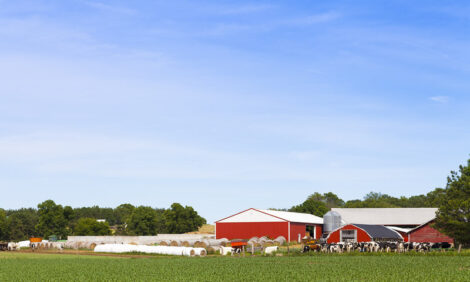



Saving Electricity in the Dairy
Milk harvesting accounts for almost half of the electricity used in dairies, but fine-tuning an operation offers ways to trim energy costs, a South Dakota State University specialist said.
“Dairy producers are among the leaders in this field as they have long recognized the importance of doing what they can to be energy-conscientious,” SDSU Extension Dairy Specialist Alvaro Garcia said.
Garcia said milk harvesting, which includes activities such as cooling and operating pumps, accounted for 42 percent of electricity use in energy audits in the state of New York. Water heating adds 4 percent. Figures from the New York State Research and Development Authority suggest that lighting (24 percent) and ventilation (22 percent) account for nearly the other half of electricity use in a dairy, while manure handling and feeding equipment use only 4 per cent and 3 per cent of electricity, respectively.
“Although upgrades on these last two areas may be necessary, producers should not expect significant savings in electricity by making changes in them,” Garcia said.
Energy usage in dairies does vary widely depending on housing. Dairies with tiestalls use 937 kilowatt hours, or KWH, per cow annually while those with freestalls used only 677 KWH. With the KWH at approximately $7 currently in South Dakota electricity costs run at $66 and $47 per cow annually for tiestall and freestall housing systems, respectively.
To reduce electricity costs, it is important to evaluate its use across the farm to determine where significant savings can be made. But Garcia and his colleague, SDSU dairy scientist Kenneth Kalscheur, offered these suggestions:
- Nearly 24 per cent of the electric bill for a dairy farm is for lighting, and fluorescent lighting is more than four times as efficient as incandescent. Switching entirely to fluorescent lighting can reduce the electricity consumed for lighting in a dairy operation to 56 KWH per cow, or close to $4 annually, compared to an average of 224 KWH per cow, or $16 annually, for incandescent.
- Ventilation to move air and reduce heat stress can cost approximately $14 per cow per year. High-volume, low-speed fans, or HVLS fans, of between 6 and 24 feet in diameter use low horsepower motors (1 HP) to generate energy-efficient air movement for large spaces. It would take six to seven standard alley fans to move the 125,000 cubic feet of air per minute moved by a 20-foot HVLS fan.
- Consider using scroll compressors in cooling systems rather than reciprocating compressors. Scroll compressors have fewer moving parts and are more energy efficient, using 20 per cent less energy and potentially saving about $3 per cow per year.
- Consider pre-cooling milk with a well-water plate cooler, taking advantage of well water that has an average annual temperature in the Midwest of about 55 degrees F. For every 100 cows milked twice a day, the estimated electricity savings would be 4,200 KWH, or about $294 ($3 per cow annually) in yearly savings if the average price for electricity is 7 cents per KWH.
- A variable speed drive to help regulate the rate at which a milking system pumps milk and washes the system will allow pump motors to work at lower speeds much of the time, saving about 60 percent of the cost of running pumps at a fixed speed. For 100 cows milked twice a day, and energy costs of 7 cents per KWH, the estimated savings of 2,040 KWH/year, or $143, is about $1.40 per cow per year.
May 2009


